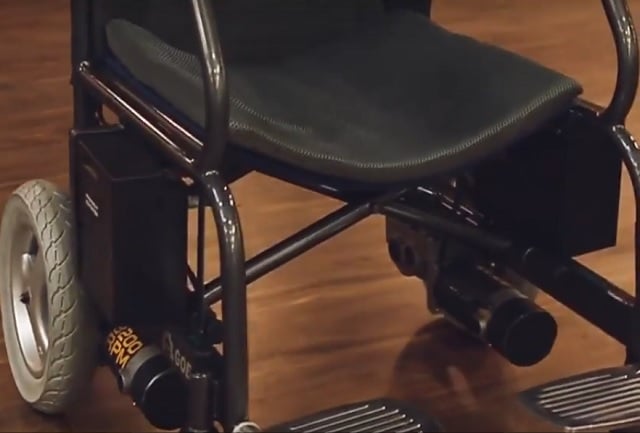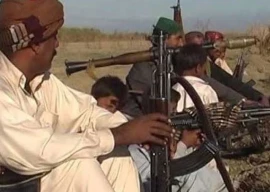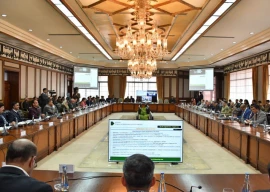
Footbridges despite their global popularity to facilitate urban pedestrians are a relatively new concept in Pakistan’s context reflected by the masses lack of sensitization towards them.
Their recent upsurge in the country’s urban centers is a welcome development because it translates into a decrease in instances of people squeezing through road-dividing metal fences (often by bending the fence) to cross roads and pedestrian deaths.
However, the problem with footbridges in Pakistan, apart from their low numbers, is their disenfranchisement of the paraplegic population. Areeb, a 19-year-old differently-abled person from Lahore, terming the country’s second most populous city’s pedestrian bridges as meaningless for people like him, informed the Express Tribune that most people cross the road on these pedestrian bridges with their buffaloes and goats.
Even if livestock crossing’s were stopped the city is not differently-abled person friendly. Usman Sheikh, a job-seeking special needs person, feels this on a personal level as the thought of crossing Lahore’s busy roads is daunting to him.“My ID card highlights my disability with a wheelchair sign but the government has done nothing to facilitate me. The pedestrian bridges are of no use to me as I cannot cross them alone on my wheelchair,” he said.
Shortcut for motorcyclists
While other cities’ footbridges might be lucky as to not be used by livestock, they are prey for motorbikes. For instance, in Karachi, the three wheelchair ramps that exist, on the city’s measly count of 130 pedestrian bridges, built in the last 40 years, are inaccessible due to the former city government installing barriers to prevent motorcycle entry. To illustrate further, at the Natha Khan bus stop on Shahra-e-Faisal, the traffic police has completely blocked the ramp by placing a 3 feet high concrete barrier. Raza Hussain, Executive Engineer at Traffic Engineering Bureau of Karachi Development Corporation, while talking to Express Tribune, said that barriers were installed on the ramps because it was not possible for his organization to stop the entry of motorcyclists. “We cannot do the traffic police’s job for them,” Hussain remarked. Apart from pesky bikers, Karachi’s footbridges are dysfunctional. An official of the Traffic Engineering Bureau (TEB) of the Karachi Development Authority told the Express Tribune on condition of anonymity that at present 112 pedestrian bridges are under the control of TEB but due to a lack of funds and qualified staff these are useless.
Read More: Man slays disabled daughters
The supposed trendsetter that is the federal capital and its neighbor Rawalpindi, do not offer much hope either. Talking to the Express Tribune, Naveed Ikram, President of the Disabled Persons Association, said, “we face severe difficulties on the bridges in Islamabad and Rawalpindi as most of the ramps paved are fit for motorcyclists’ use not for wheelchair users.” The twin-cities share a tally of roughly 30 pedestrian bridges but as per Ikram, the elevation of ramps on these bridges and the material used in their construction are not good for a wheelchair. Assistant Director, Asif Mehmood, of the Capital Development Authority (CDA), offering some hope said, “in the future we will build bridges with a separate slob path for both paraplegics and motorcyclists.”
A similar ray of hope for Rawalpindi is not on the cards though as currently 3 new footbridges are being constructed in the city at an estimated cost of Rs. 100 million, as per Rawalpindi Development Authority (RDA), and none includes a safe passage for wheelchair users.
Insufficient public transport infrastructure
Even Pakistan’s multi-billion rupee public transport infrastructure does not accommodate wheelchair users. Islamabad’s Metro Bus service stations’ elevators and escalators for special needs persons are not functional. Several users of the service informed the Express Tribune that these elevators and escalators were in good condition when the service started operating, now most of them have become mere exhibits.
Such a conundrum exists in Peshawar too. Irfan Ullah, the representative of an NGO for paraplegics, talking to the Express Tribune said, “the initial feasibility report of the multibillion [Bus Rapid Transit (BRT)] project had completely ignored people who cannot walk which is why I went to court against the project.” Despite the fact that there are now clear court orders after Irfan’s case, Peshawar’s BRT has yet to give access to paraplegics. The city in general does not offer many pedestrian bridges so facilitating differently-abled persons is a long shot. “No, there is no ‘access’, let alone safe road crossings for Peshawar’s pedestrians,” Irfan told the Express Tribune.
Unable to navigate cities on their own and deprived of public transport facilities, the country’s paraplgeic population is resigned to paying high rickshaw and cab fares. Sofia Naveed, resident of Lahore, is a 37-year-old polio victim who cannot walk, informed cabbies charge her more because as per the drivers they have to travel more than a ‘normal ride’ to get her to her doorstep. Karachi resident, Muhammad Asim, seconding Sofia, said, “I have to take an expensive rickshaw ride just to cross the road all due to dysfunctional pedestrian bridges.”














1736070587-0/Express-Tribune-(2)1736070587-0-270x192.webp)
1737452260-0/Gaddafi-stadium-(2)1737452260-0-270x192.webp)
1737531830-0/Saim-Ayub-injury-(2)1737531830-0-270x192.webp)









COMMENTS
Comments are moderated and generally will be posted if they are on-topic and not abusive.
For more information, please see our Comments FAQ